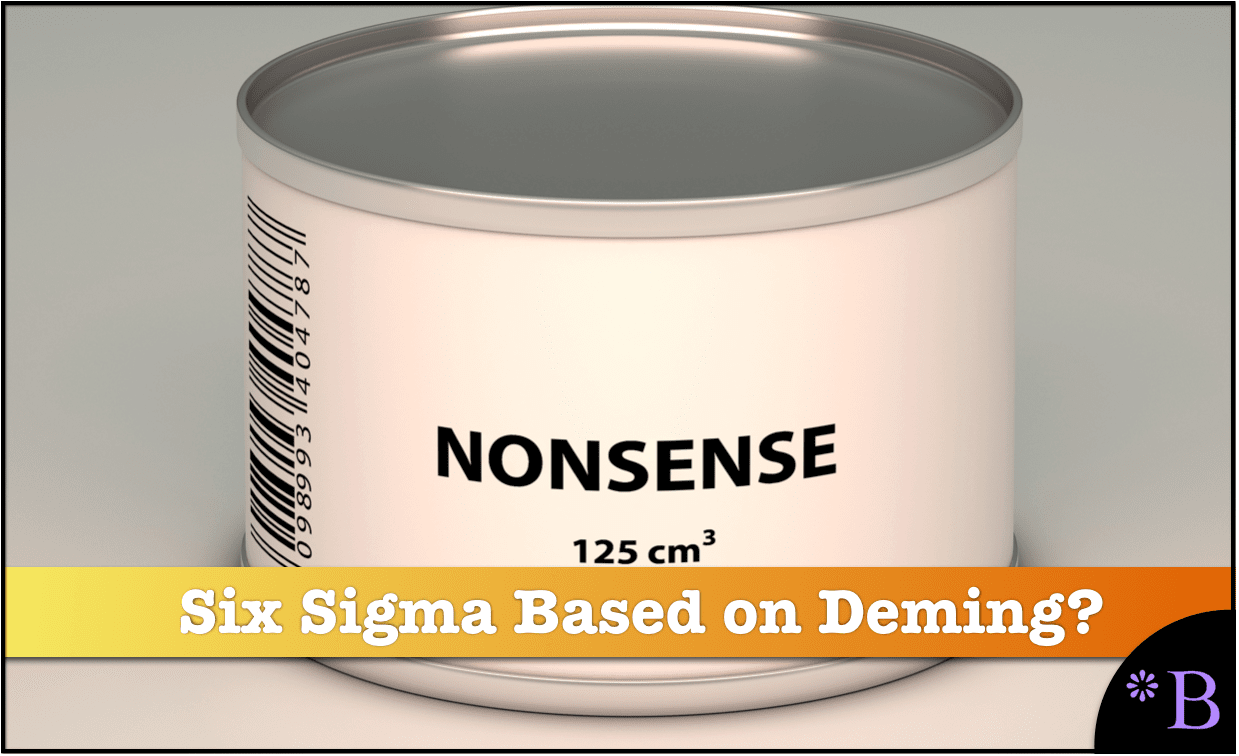Six Sigma Was Not Based Upon the Quality Work of Deming
Executive Summary
- Six Sigma proponents and many articles have claimed that Six Sigma or “Japan Six Sigma” was based upon Deming.
- This is untrue, and we cover why this claim is false.

Introduction
Six Sigma proponents have, for decades, proposed that Six Sigma or “Japan Six Sigma” is based upon Japanese quality methods.
Quarts on the Foundation of Six Sigma on Deming
While reading through the article Whatever Happened to Six Sigma on Quartz related to “Japan Six Sigma,” this false information is provided.
Six Sigma was born out of the theories of a small group of mid-century engineers who became apostles of quality control. Chief among them was W. Edwards Deming, an American statistician who traveled to Japan to teach manufacturing techniques in 1950. Japan, in desperate need to reinvent its industry in the aftermath of World War II, was eager to learn, and the companies that adopted his techniques of statistical process control saw enormous gains. Deming became a hero to Japanese industry and the Deming Prize is still awarded by the Union of Japanese Scientists and Engineers to companies that master his methods.
The key to Deming’s techniques was the close observation of manufacturing processes and the meticulous recording of data. Only by closely studying outputs could managers understand if defects were the product of random chance, or flaws in manufacturing equipment or raw materials. The process was applied continually to narrow the variability in finished products.
Deming believed quality control was an organization-wide imperative, and insisted on involving CEOs when he worked with companies. He pushed corporations to break down barriers of communication between workers and managers, and to eliminate production quotas and targets that could compromise the process.
By the 1970s, Japanese automobiles and electronics surpassed US products in quality and reputation, and American manufacturers took note. (In 1980, NBC aired a documentary on Japanese management techniques titled, “If Japan Can, Why Can’t We?“) Deming became a sought-after consultant by companies like General Motors and Ford.
Deming’s methods became systematized into Six Sigma at Motorola, a consumer electronics company battered by Japanese competition. Bill Smith, an engineer, developed and named it in 1985, and CEO Bob Galvin made it a company-wide initiative.
– Quartz
In this video, the Deming connection is made again and, therefore, to “Japan Six Sigma.”
Six Sigma proponents frequently make multiple false claims to support the adoption of Six Sigma.
The Reality of Deming’s View of Six Sigma
The following are quotes that Dr. Tony Burns found.
Six Sigma takes quality backwards to 1870 and the go-no-go gauge, counting defects, approach to quality. Counting defects appeals to simplistic ‘carrot and stick’ MBO managers. However, “A numerical goal leads to distortion and faking, especially when the system is not capable of meeting the goal.”
Six Sigma believers fail to comprehend the difference between analytic and enumerative methods. Hypothesis testing is irrelevant to process improvement. “The student should avoid passages in books that treat confidence intervals and tests of significance, as such calculations have no application in analytic problems in science and industry.” – Professor Deming
And then the following.
Six Sigma believers fail to comprehend modern quality: “On target with minimum variance”, – Professor Deming, Dr Shewhart, Dr Taguchi, and Dr Wheeler.
For something that was supposedly based upon the work of Deming, Deming seems extremely critical of Six Sigma and “Japan Six Sigma.”
Overgeneralizing Quality Improvement to “Japan Six Sigma”
Both Six Sigma and Deming were focused on quality improvement and also on statistical process control. However, Six Sigma is not “based” on Deming. Furthermore, there is little evidence that Japanese manufacturing companies like Toyota ever implemented or even esteemed Six Sigma or a version of “Japan Six Sigma.”
The Fake History of Six Sigma
One of the signs that something is false is that the proposer creates a false history. The Deming quotes are telling. There is not a more influential person in the Japanese quality movement than Deming. If Deming thinks Six Sigma is poppycock, then.
- <lia.) one has to question the proposal by Six Sigma proponents as to its basis in Japanese quality, and
- b.) Six Sigma’s basis in SPC.
The first question that anyone should ask is if a story is true; why is the story proponent faking history?
Conclusion
The assertion that Six Sigma is based upon the work of Deming receives a 0 out of 10 for accuracy.
It is designed to borrow the prestige of the Japanese quality improvement program and the work of Deming by creating a fallacious linkage between the two very different quality improvement philosophies. Deming’s approaches are proven and based on logic and solid mathematical principles. Six Sigma is unproven, and in fact, the evidence is that Six Sigma is counterproductive, and it is based upon false statistical claims.
To find out more about the decline of GM and Six Sigma, see the article How Will GE’s Decline Impact the Cult of Six Sigma?
References
https://qz.com/work/1635960/whatever-happened-to-six-sigma/
https://www.linkedin.com/pulse/broken-dr-tony-burns/?trackingId=2JLeVHZWQlmcq7POwDH%2FcA%3D%3D